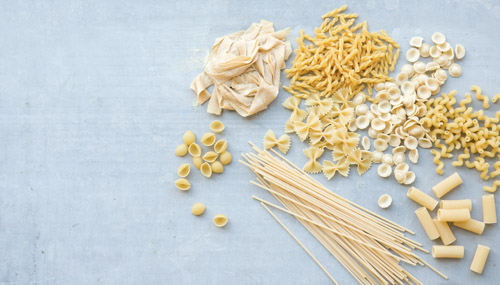ANATOMY OF A PASTA DISH
All pastas can be divided into two basic types, dried and fresh. One is not better than the other, but rather each has its own role in the pasta repertoire. Dried pasta has a chewy, hardy texture with a slightly rough surface, while fresh pasta is soft, silky, and moist. Keep packages of your favorite dried pasta shapes on hand for a quick meal. Because fresh pasta is perishable, purchase it or make it no more than a day in advance of serving.
Sauces can be heavy or delicate, fluid or chunky, rustic or refined. A rich sauce, such as a cream-based Alfredo, should just barely coat the pasta, while a tomato-based sauce, such as amatriciana, can be applied more generously.
A dusting of grated Parmesan cheese, a drizzle of extra-virgin olive oil, a sprinkle of flaked sea salt or red pepper flakes, a scattering of buttery bread crumbs or chopped herbs–each of these toppings can heighten the flavors of a pasta dish and elevate the final result.
Different dried pasta shapes–smooth or ridged, long or short, thick or thin–capture and absorb sauces differently. For example, the craters and curves of the larger shapes, such as fusilli, rigatoni, or ziti, are designed to trap chunky, rustic sauces, while small shapes, like pennette, typically marry well with smooth sauces, such as pesto. Long, thin strands also mate well with fluid mixtures, while ribbons, such as fettuccine, can handle a heavier sauce. Delicate and porous fresh pasta is ideally matched with rich sauces made from butter or cream.
When pairing a pasta shape and a sauce, always keep this basic tip in mind: large pieces of protein or vegetable pair better with large pasta shapes, such as rigatoni or ziti, while thinly sliced, more tender foods, like asparagus or mushrooms, are better suited to a thin strand or ribbon pasta, such as spaghetti or tagliatelle.
